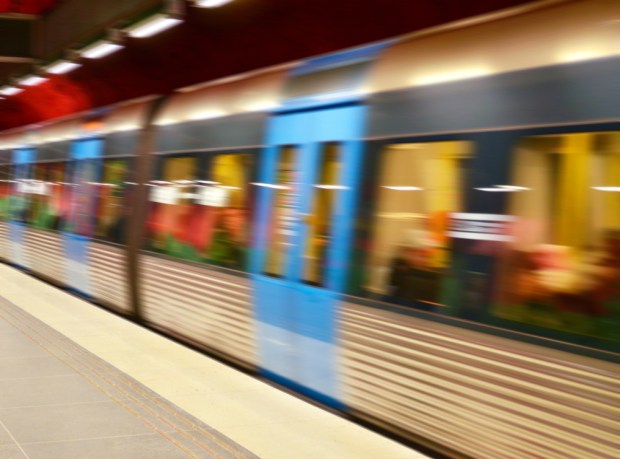Mastercard’s Kirkpatrick: Transit Is The Ticket To Everyday Spend

The current best-in-class method of payment for a ride on a subway in any American city works just fine – until it doesn’t. Loading funds onto a prepaid card that opens the turnstile once scanned, swiped or inserted works terrifically well – until the customer forgets to check the balance on his transit pass, and finds himself locked out at the turnstile.
And, of course, that moment never occurs on a day when one is early. It will only happen when one is running late, and the four extra minutes spent loading money onto a transit pass is the difference between sliding in as the doors are closing and waiting 20 minutes for the next train.
It’s an annoyance that Mastercard is hoping will soon be a (not fondly remembered) relic of the past. As of last week, the card network announced it will be bringing contactless payments to transit turnstiles in more than 20 U.S. cities in the next few years.
“The transit vertical is, for us, catalyzing so many ways consumers are going to pay in the future, and front and center is contactless,” Linda Kirkpatrick, executive vice president of U.S. Merchants and Acceptance for Mastercard, told Karen Webster shortly after the news went public. “We’ve been working for a long time now with multiple cities across the U.S. and globally. What we announced is really the culmination of many years of work.”
Work, she noted, that starting next month will soon change the lives of millions of commuters nationwide, starting in New York City – and will give card issuers greater opportunity to stay at the top of consumers’ wallets.
Building New Consumer Habits
What is remarkable about the change underway, Kirkpatrick noted, is that in New York City, nine million daily consumers will have access to a “transformational change” at the terminal, without having to alter their behavior at all.
In fact, she noted, their behavior at the turnstile will much more closely resemble their familiar everyday payments experiences – they will just take out their Mastercard-branded plastic card and, quite literally, tap and go at the turnstile. No more stutter step of buying and reloading a closed-loop transit pass to hop on the train.
That’s not to suggest these closed-loop systems are going the way of the paper ticket anytime soon. Those systems still have to serve everyone, including cash-only customers. But, Kirkpatrick noted, in the 20 or so cities Mastercard is working with, over the next few years, the vast majority of consumers who carry that particular type of plastic card will have a better option.
“This is now about one product that works for your entire life,” Kirkpatrick said, noting that Mastercard has already embedded its contactless-enabling technology in 16 metro areas, including Los Angeles, Boston, New York and Denver, “which means this is no longer a change coming on the hypothetical horizon, but one coming very soon.”
Riding the Inflection Point
Contactless technology in the U.S., when stacked up against the U.K. and Europe, for example, is lagging. But, Kirkpatrick noted, everywhere one looks these days are signs of that changing.
“When we look at the statistics worldwide, we see 60 percent of our transactions happening at contactless terminals, and that is growing every day. We have commitments from issuers – who represent ⅔ of our total volume – that they are going to start issuing by the end of 2020. And then you layer on 20 cities for transit.”
Transit, she and Webster agreed, is among the more habit-forming use cases, because it so consistent. Customers ride the subway at least twice a day to and from work – and how they pay during that interaction starts to have a lot of relevance to how they pay during all other interactions. When they get off the train, they might want coffee or breakfast, or (if they happen to be having a rather old-school morning) a print edition of the newspaper.
That tap-and-go interaction for their ticket to ride starts building the habit to use a contactless card everywhere, Kirkpatrick noted. And for the issuers, it increasingly becomes a no-brainer to issue those cards, because it is always in their best interests to make their card the standout with the most useful feature.
“What better to get top-of-wallet relevance than embedding a contactless chip in your card?” Kirkpatrick mused.
Moreover, she told Webster, as she uses a contactless card in her day-to-day life, other customers often act as though she has performed a magic trick at the POS when she taps her card, asking excitedly where they can get one.
The journey to get here has been long, Kirkpatrick told Webster, because that is the nature of the beast in payments. Many things had to happen, particularly embedding safety and security around these transactions so this great new innovation doesn’t end up enriching fraudsters. What they’ve learned over the last several years in tackling this issue globally, she noted, is that fraud can be kept at low levels with the right multi-faceted solutions.
The question going forward, she said, is not whether this can be done – that, after many years of efforts, has been answered. The new question is, how are issuers and merchants going to build on those efforts to further build the habits?
“We have been anxiously awaiting the inflection point, and now it’s here,” Kirkpatrick said. “And I think that is going to be a net positive for the whole industry: issuers, merchants, consumers and networks alike.”
